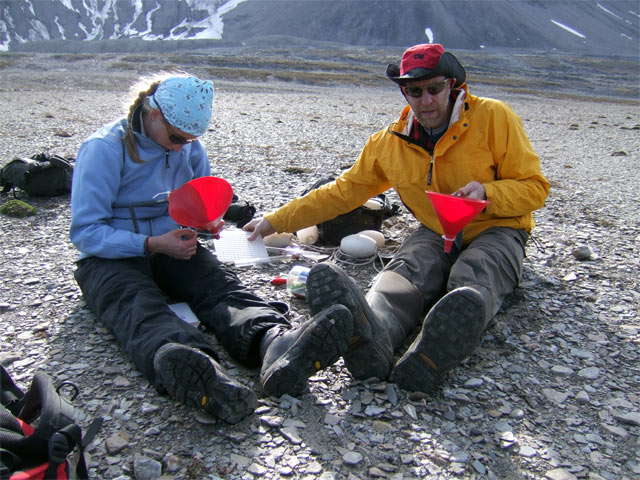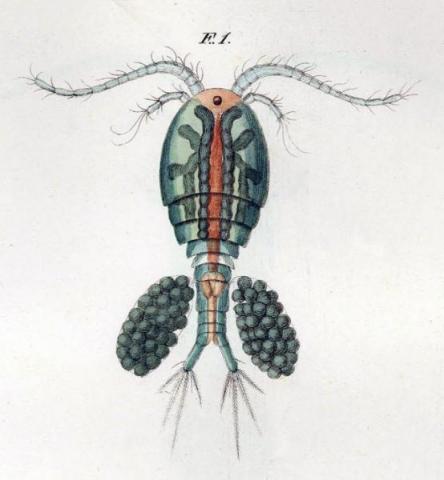( Log In ) Log In is for TREC Teachers & Researchers only
  |
| Maggie_Kane |
 Aug 6 2006, 08:27 PM Aug 6 2006, 08:27 PM
Post
#1
|
 Advanced Member    Group: TREC Team Posts: 51 Joined: 12-April 06 Member No.: 27 |
Today it rained all day. It was the first day that challenged us to get the job done. It was also blowing wind really hard, and we had to protect our faces from it. We just kept smiling and telling jokes to keep our attitudes good. I actually had a really great time, and think It was a really fun and happy day. We do have to stay mindful of our bodies, as to not get chilled, so we keep moving to stay warm.
I got to learn about Heidi’s project on Lake Linne. She is studying the sediment transport throughout the lake in hopes of getting a close look at what types of material accumulate during different seasons and weather conditions. She will correlate these with our annual weather data to better understand the factors that control sedimentation profiles. This is super important, because the cores that Bennet is working on are made of the lake bottom sediments, so if we want to understand the cores, we need to unravel the dynamics of the sediment transport system. To learn these things, Heidi will be collecting sediment traps that have been collecting lake sediment for exactly one year. Last August, research student J. Brookes Motley deployed 5 filter traps in specific locations in the lake. A rope was anchored to the bottom with a float located near the water surface, creating what we call a “mooring”. Along the length of the rope at regular intervals, he attached a small clear stoppered tube with a funnel at the top to collect sediment. Sediment Traps (putting them together on a sunny day)  Can see that some of them also included a grid of hard plastic over the top? What do you think this was for? If you guessed to keep really big stuff from blocking the tube, you were partly right. It also prevents the waves and water from stirring the sediment, causing it to mix or leave the trap. They put these grids only some of the funnels to see if it helped with sediment collection results. Close Up of Sediment Trap  Brookes also attached temperature loggers on the moorings next to the traps. This was designed to study how temperature changes at different depths in the lake and if temperature is related to sediment flux. This will help us understand more about how sediment moves around the lake. Ben is going to do some data analysis on the past year’s temperature data. These loggers can take a temperature reading every 30 minutes all year long. Temperature Loggers  Heidi and Al pulled mooring E today to look at the data from the loggers. Here is a quick graph that Ben made tonight to show the temperature in degrees Celsius at different depths along the mooring rope. Temperature Logger Graph  Temperature is on the Y axis (going up and down) and time (the date) is on the X axis (running along the bottom). The graph covers one year, with the start and stop date in August. There are three colors, each one representing a different trap along the rope. Just looking quickly at the graph you should be able to see a few things about the water temperature. When did the water start getting cold? What do you think the lake was like between November and May? When was the water the warmest? What temperature was the warmest? How many degrees on the Fahrenheit scale is that? Post your answers on “Ask the Teacher and Scientist” forum as a new post and I’ll get back to you. Here is what the traps looked like when Heidi pulled them up today.   She thinks that some of the cores may be a bit “bioturbated”, meaning stirred up a bit by organisms. Freshwater copepods live in the mud and can burro in and make the layers a bit messy. Here is a diagram of what a copepod might look like. Copepod Diagram  Heidi also deployed 2 summer traps the first day when we first got here. These will be used to calibrate the layers very carefully and hopefully match up with the top layers of the year long traps. When we set those moorings, we attached large rocks as an anchor and gently dropped them down to the bottom at a chosen point. Those too will be picked up on Wednesday. Deploying Traps  We are heading into our last week in the field here. The time has gone very fast! We still have so much to do, but the data collection is going really well. We have started to experience true arctic weather which means… strong wind and cold rain. I took a few pictures to show you what that looks like. First Really Rainy Day   If you have on weatherproof clothes and keep a good attitude, it is really fun! Keeping the Spirits High  Me Working in the Stream  |
  |
1 User(s) are reading this topic (1 Guests and 0 Anonymous Users)
0 Members:

|
NSF Acknowledgment & Disclaimer | Time is now: 16th November 2024 - 01:17 PM |
Invision Power Board
v2.1.7 © 2024 IPS, Inc.








